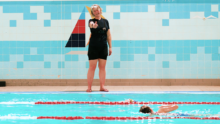
Top tips for preparing for open water swimming in the pool
23/06/2016Preparing for open water swimming in a warm, comfortable pool is a good stepping stone to the real thing.
Jumping into a large body of water for the first time can be a bit of a shock. So, we have compiled some top tips to what you can do in the pool to prepare.
Preparing for open water swimming: strokes
- It is vital to be comfortable with your stroke in open water. Most open water swimmers choose front crawl, so start by making sure yours is in good shape in the pool.
- Try get competent in another stroke, such as breaststroke. You may need to recover in open water and breaststroke uses less energy than front crawl.
- Open water swimming is no splash and dash. They are at least 500m. Use pool time to ensure you can confidently swim further than the event you are entering without having to put your feet down.
- Use the Just Swim App distance goals to gradually build up your distance.
Preparing for open water swimming: techniques
So your front crawl is awesome and your endurance off the chart. But you need to prepare for a few more surprises open water can spring on you.
Sighting
- In the open water there are no lane lines. You need to practice looking ahead during your swim to find a marker in the distance to follow.
- Looking up is a simple thing to practice in the pool. Try perfecting it so you don’t disrupt your rhythm.
- Practise swimming in a straight line. Close your eyes while swimming and see whether you veer left or right (most people do). Try tweaking your stroke to straighten your natural line.
Treading water
- There is no wall to hold or kick off from in open water. Use pool time to get used to treading water in the deep end. You could spend a lot of time treading water in open water.
Turning
- Most events will involve turning around a marker buoy, often four or five times a race. If you have space in the pool and a willing practice-mate, swim up to and round your friend without touching the walls or bottom of the pool.
Breathing both ways
- Breathing on alternative sides in open water events is a necessity. It may not feel natural at first, but focus on your technique in the pool and it will become more comfortable.
- Let your head and spine join the rotation of your shoulders, inhale sharply then turn your face smoothly back in time with your shoulder rotation.
Group swimming
- Lots of people swimming together can come as a bit of a shock the first time you swim in an open water event. Practise group swimming with four or five of your friends in one lane of the pool to help get used to the feeling.
 Just Swim
Just Swim



